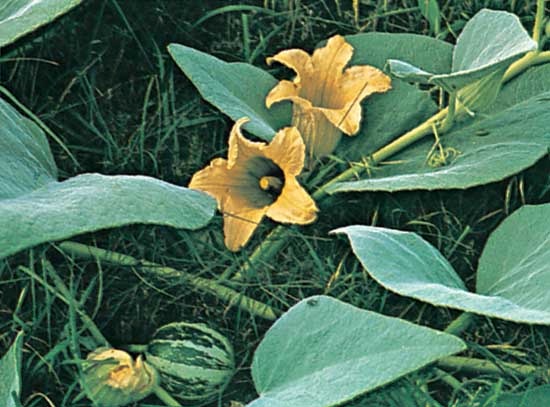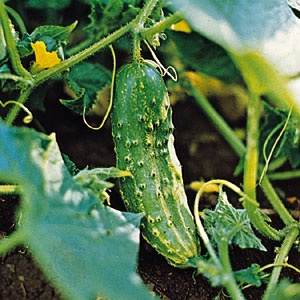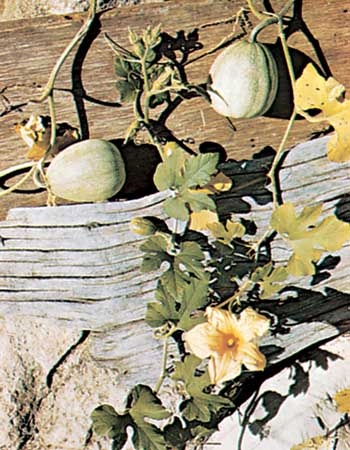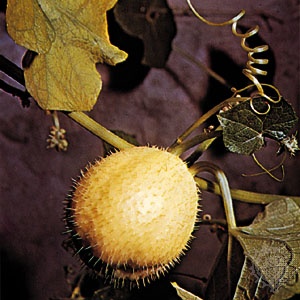Cucurbitales
plant order
Introduction
 small order of flowering plants containing seven families, 129 genera, and 2,295 species. It includes Begoniaceae, or the begonia family, with 60 percent of the species in the order, and Cucurbitaceae, or the squash, gourd, and cucumber family, with 90 percent of the genera in the order. In addition, Cucurbitales includes five small families: Anisophylleaceae, Coriariaceae, Corynocarpaceae, Datiscaceae, and Tetramelaceae.
small order of flowering plants containing seven families, 129 genera, and 2,295 species. It includes Begoniaceae, or the begonia family, with 60 percent of the species in the order, and Cucurbitaceae, or the squash, gourd, and cucumber family, with 90 percent of the genera in the order. In addition, Cucurbitales includes five small families: Anisophylleaceae, Coriariaceae, Corynocarpaceae, Datiscaceae, and Tetramelaceae. Cucurbitales is a Rosid I order and is close to Fagales. Species in the order tend to have the veins in the leaf radiating from the base; the sepals and petals often are not sharply different; and the styles are free. Many species have inferior ovaries, and male and female flowers are often distinct, although usually borne on the same plant.
Cucurbitales is a Rosid I order and is close to Fagales. Species in the order tend to have the veins in the leaf radiating from the base; the sepals and petals often are not sharply different; and the styles are free. Many species have inferior ovaries, and male and female flowers are often distinct, although usually borne on the same plant.Cucurbitales is a curious assemblage of families. Cucurbitaceae, Datiscaceae, and Begoniaceae traditionally have been placed together, often with other families that have ovules on the walls of the ovary, such as Violaceae, or the violet (Viola) family. Corynocarpaceae has long been a family of uncertain position. Before DNA studies, Coriariaceae was linked with Ranunculaceae because of its separate carpels. Anisophylleaceae was formerly linked to or included in Rhizophoraceae, a family that now belongs to the order Malpighiales but in the past was often linked to the order Myrtales. Flowers of some Anisophylleaceae are remarkably like those of some Cunoniaceae (order Oxalidales), down to the fine details observable during development, but this seems to be because of a mixture of persistence of a common ground plan and evolutionary convergence. For more information on the modern Angiosperm Phylogeny Group II (APG II) botanical classification system, see angiosperm.
Begoniaceae
 Members of Begoniaceae are succulent herbs or sometimes climbers; there are 2 genera and more than 1,400 species, and they occur throughout the tropics and into subtropical regions. begonia includes all the species in the family minus one; it occurs throughout the family's range but is not native to Hawaii. The excluded species is Hillebrandia sandwicensis, which is restricted to Hawaii. The family often has leaves in two ranks; the base of the blades is asymmetrical, and there are well-developed teeth and stipules. The plants have both male and female flowers (flower) in the same flowering unit ( inflorescence). Begonia has petals and sepals that are petal-like, a form known as tepals. The ovules are borne in the centre of an inferior ovary, and the stigmas are large, divided, and often twisted. The fruit is a capsule, often with asymmetrical wings, or rarely a berry.
Members of Begoniaceae are succulent herbs or sometimes climbers; there are 2 genera and more than 1,400 species, and they occur throughout the tropics and into subtropical regions. begonia includes all the species in the family minus one; it occurs throughout the family's range but is not native to Hawaii. The excluded species is Hillebrandia sandwicensis, which is restricted to Hawaii. The family often has leaves in two ranks; the base of the blades is asymmetrical, and there are well-developed teeth and stipules. The plants have both male and female flowers (flower) in the same flowering unit ( inflorescence). Begonia has petals and sepals that are petal-like, a form known as tepals. The ovules are borne in the centre of an inferior ovary, and the stigmas are large, divided, and often twisted. The fruit is a capsule, often with asymmetrical wings, or rarely a berry.Male and female flowers of Begonia may have different numbers of tepals; male flowers open first at the base of the inflorescence, with female flowers appearing later. Both stigmas and anthers are often bright yellow. The flowers usually contain no nectar, though bees and other pollinators may visit the female flower expecting to find pollen—a kind of “deceit pollination.” The seeds of Begoniaceae have a small lid surrounded by specialized cells. Begonia rex can produce plantlets directly from the leaf, which is very unusual in flowering plants. How Hillebrandia came to be restricted to Hawaii is unknown; the genus appears to have originated well before Begonia, more than 50 million years ago, but the Hawaiian Islands are volcanic and of much younger age. Hillebrandia has a number of “primitive” features, including the presence of five sepals and five small petals in female flowers and an only partly inferior ovary.
The leaves of some African and Asian Begonia species are edible; in South America some species are eaten to prevent scurvy. Rhizomes (rhizome) of certain species in South America are used for their medicinal qualities as astringents, as treatment for fever, as antisyphilitics, and as laxatives.
Begonia is of considerable horticultural interest, with many species and hybrids prized as house or garden plants. Classifications of begonias for horticultural purposes are quite different from those for botanical studies, with species valued for their potential in producing hybrids rather than their botanical relationships. Variations in growth habit, leaves (including colour patterns), inflorescence type, flower size and colour, and length of blooming period are all of horticultural value.
Three groups of species are of particular interest to horticulturists. One is cultivated for its leaves, including especially B. rex. Another, valued for its flowers, is subdivided into a group of small-flowered plants centred on B. cucullata (more commonly called B. semperflorens) and a group of large-flowered plants, including the tuberous begonias, such as B. rosaeflora, B. veitchii, B. boliviensis, and B. x tuberhybrida. A third group has both ornamental flowers and decorative leaves and includes B. scharffiana and B. metallica, from which came the hybrid B. x credneri. Modern growers place begonias in four groups: (1) fibrous-rooted, including the wax (B. semperflorens), the cane-stemmed, and the hirsute, or hairy, (2) the rhizomatous, (3) the rex-cultorum, or rex, and (4) the tuberous-rooted.
Cucurbitaceae
 Members of Cucurbitaceae are vines with tubers, lianas, or annual herbs. They are found throughout the tropics and in warm temperate areas. There are 118 genera and 845 species in the family—far more genera than in Begoniaceae but fewer than two-thirds the number of species. Momordica (45 species) and Cucumis (52 species) are found in the Paleotropics. Sechium (about 6 species) grows in the Neotropics, as does Cucurbita (13 species), although it has a rather wider distribution there. Citrullus (about four species) grows mostly in Africa. Members of Cucurbitaceae often have rather roughly hairy, toothed leaves with palmate venation but no stipules. In each leaf axil there is some combination of a tendril growing off to one side, a vegetative bud, a female flower, and an inflorescence. The flowers are of separate sexes, either on the same or on different plants, and the flowers have a tube on which the sepals and petals arise. The stamens are fused together in the centre of the flower, and the anthers, or pollen sacs, are often twisted in a very complex fashion. The seeds are borne in three areas down the walls of the inferior ovary. The fruit is a rather dry berry, and the seeds are flattened. Sometimes the fruit opens, allowing beautifully winged seeds to float to the ground.
Members of Cucurbitaceae are vines with tubers, lianas, or annual herbs. They are found throughout the tropics and in warm temperate areas. There are 118 genera and 845 species in the family—far more genera than in Begoniaceae but fewer than two-thirds the number of species. Momordica (45 species) and Cucumis (52 species) are found in the Paleotropics. Sechium (about 6 species) grows in the Neotropics, as does Cucurbita (13 species), although it has a rather wider distribution there. Citrullus (about four species) grows mostly in Africa. Members of Cucurbitaceae often have rather roughly hairy, toothed leaves with palmate venation but no stipules. In each leaf axil there is some combination of a tendril growing off to one side, a vegetative bud, a female flower, and an inflorescence. The flowers are of separate sexes, either on the same or on different plants, and the flowers have a tube on which the sepals and petals arise. The stamens are fused together in the centre of the flower, and the anthers, or pollen sacs, are often twisted in a very complex fashion. The seeds are borne in three areas down the walls of the inferior ovary. The fruit is a rather dry berry, and the seeds are flattened. Sometimes the fruit opens, allowing beautifully winged seeds to float to the ground.The tendrils of Cucurbitaceae are part of a branch complex and themselves may be branched or not; they coil like watch springs when attaching to a support. Some botanists suggest that they are modified shoots. Many Cucurbitaceae have a nectary disc, and pollination by bees is common; cultivated members of the family are pollinated in this way. The seed coat is mucilaginous, aiding in its dispersal by animals, but wind-dispersed species have winged seeds. Fruits of Ecballium (squirting cucumber) fall from the plant when ripe, and the contracting skin forces the watery pulp through the hole where the fruit stalk was attached, ejecting the seeds along with it.
 Some species from Cucurbitaceae have been cultivated by humans for millennia and are now spread around the world. Citrullus lanatus ( watermelon) is native to tropical and subtropical Africa and was grown in Egypt in prehistoric times. Dried fruit pulp of other species of Citrullus is a purgative.
Some species from Cucurbitaceae have been cultivated by humans for millennia and are now spread around the world. Citrullus lanatus ( watermelon) is native to tropical and subtropical Africa and was grown in Egypt in prehistoric times. Dried fruit pulp of other species of Citrullus is a purgative. The large genus Cucumis produces gherkins (gherkin), melons (melon), and cucumbers. West Indian gherkins (gherkin) (C. anguria) are commonly used as pickles but are also eaten as cooked vegetables and used in curries; the species originated in Africa. C. melo, also from Africa, produces several varieties of melon, including cantaloupes, muskmelons (muskmelon), winter melons, and honeydew melons. Fruits of C. sativus ( cucumber) are eaten as vegetables or (in their immature form) made into pickles. This plant may have been domesticated in northern India.
The large genus Cucumis produces gherkins (gherkin), melons (melon), and cucumbers. West Indian gherkins (gherkin) (C. anguria) are commonly used as pickles but are also eaten as cooked vegetables and used in curries; the species originated in Africa. C. melo, also from Africa, produces several varieties of melon, including cantaloupes, muskmelons (muskmelon), winter melons, and honeydew melons. Fruits of C. sativus ( cucumber) are eaten as vegetables or (in their immature form) made into pickles. This plant may have been domesticated in northern India. Cucurbita is native to the New World and produces a variety of gourds, melons, squashes (vegetable marrows), and pumpkins (pumpkin). The agricultural system in much of pre-Columbian America was based on squash, beans (bean), and corn (maize). C. pepo, varieties of which provide summer squash, winter squash, zucchini (courgette), common pumpkin, and ornamental gourds, was cultivated as much as 10,000 years ago in the region of present-day Mexico.
Cucurbita is native to the New World and produces a variety of gourds, melons, squashes (vegetable marrows), and pumpkins (pumpkin). The agricultural system in much of pre-Columbian America was based on squash, beans (bean), and corn (maize). C. pepo, varieties of which provide summer squash, winter squash, zucchini (courgette), common pumpkin, and ornamental gourds, was cultivated as much as 10,000 years ago in the region of present-day Mexico. The hard dry shells of the mature fruits of Lagenaria siceraria (bottle gourds) are used for bowls, ladles, spoons, and many other utensils. The luffah (luffa) (Luffa aegyptica), or vegetable sponge, has a network of vascular bundles in the fruit that looks similar to the structure of a marine sponge. Momordica charantia (bitter gourd, or balsam pear) is an ingredient in curries or pickled fruit. Sechium edule ( chayote), which is native to present-day Mexico and Central America, produces a large pear-shaped fruit with only a single seed (an unusual feature in the order), as well as a large tuberous root, both used as vegetables. Trichosanthes cucumerina, also known as T. anguina (snake gourd), has fruits up to 2 metres (6.5 feet) in length; it has long been cultivated from India to East Asia.
The hard dry shells of the mature fruits of Lagenaria siceraria (bottle gourds) are used for bowls, ladles, spoons, and many other utensils. The luffah (luffa) (Luffa aegyptica), or vegetable sponge, has a network of vascular bundles in the fruit that looks similar to the structure of a marine sponge. Momordica charantia (bitter gourd, or balsam pear) is an ingredient in curries or pickled fruit. Sechium edule ( chayote), which is native to present-day Mexico and Central America, produces a large pear-shaped fruit with only a single seed (an unusual feature in the order), as well as a large tuberous root, both used as vegetables. Trichosanthes cucumerina, also known as T. anguina (snake gourd), has fruits up to 2 metres (6.5 feet) in length; it has long been cultivated from India to East Asia.Other families
Members of Corynocarpaceae are evergreen trees. The family contains a single genus, Corynocarpus, with six species growing from New Guinea to New Zealand and islands in the western Pacific Ocean. The plants have leaves with secondary veins that radiate all along the midrib. Its flowers are rather small, and the stamens are opposite the petals; they alternate with petal-like nonfunctional stamens that have a nectar-secreting scale at the base. The ovary has only one ovule and the fruit is fleshy, with a large stone inside. The plant is very poisonous, possessing bitter glucosides.
Members of Coriariceae are shrubby plants. There is a single genus, Coriaria, in the family, with five species that grow around the southern part of the Pacific Ocean to China, the Himalayas, and the Mediterranean region; the plants also grow in the Andes from Chile northward, continuing into the mountains of Mexico. The branches of Coriaria often look like compound leaves of fern fronds; their leaves are actually small and opposite and are held in a single plane. The flowers are grouped into racemes and have a perianth in two rather similar whorls. The carpels are typically separate from each other, with long styles coming from near their bases. The fruits are dry, but the perianth parts become very fleshy and entirely surround them. Coriaria has an association with the actinomycete fungus Frankia, which forms nodules on the roots. The plant is poisonous and contains bitter sesquiterpenoid compounds.
Members of Anisophylleaceae are evergreen trees or shrubs found scattered through the tropics. There are 4 genera and 34 species in the family. Anisophyllea (30 species) is pantropical. The leaves are borne in two main ranks on the stem and are often unequal in size. The flowers are small and rather undistinguished; the ovary is inferior; and the fruit is fleshy and has a stone or is dry and winged.
Tetramelaceae includes two genera (Tetrameles and Octomeles) of Indo-Malesian (see Malesian subkingdom (biogeographic region)) trees, each with one species. Male and female flowers occur on different trees and are borne in pendulous spikes. The ovary is inferior, with the ovules borne on the walls, and the short styles are borne in a ring near the edge of the ovary. The fruit is a capsule, and the seeds are small. Both genera, but particularly Octomeles, are massive, fast-growing trees, and the rather soft wood is especially prized for making canoes.
Members of Datiscaceae are perennial herbs. There is one genus, Datisca, with two species, one growing in western North America and the other growing from Crete to India. The leaves are deeply divided to pinnately compound. The flowers are of two sexes; there are no petals; and the styles are borne toward the margin of the inferior ovary rather than on the centre, and the ovules are borne on the walls of the ovary. The fruit is a capsule. The roots of Datisca harbour colonies of nitrogen-fixing Frankia fungi. Both pollination and dispersal are aided by the wind. The seeds of Datisca have a small lid, but it is not surrounded by a ring of specialized cells, as in Begoniaceae. D. cannabina, the Asian species, is an ornamental grown for its foliage, and it also yields a yellow dye.
- dawsonite
- Dawson River
- Dawson, Sir John William
- Dawānī
- Dax
- Daxue
- Daxue Mountains
- day
- Dayak
- Dayananda Sarasvati
- Dayan, Moshe
- Day, Arthur L.
- Day, Benjamin Henry
- day-care centre
- Day, Clarence
- Day, Doris
- Day, Dorothy
- Daye
- dayflower
- Day, John
- Day-Lewis, C.
- Day-Lewis, Daniel
- Daylight Saving Time
- day lily
- Day Martin Luther King, Jr.